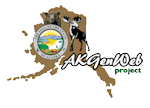



|
|
POPULATED PLACES
|
KakePop. 455 Touristy Description: A beachfront village with a fishing, logging and subsistence lifestyle, you can find the town of Kake on the edge of the Tebenkof Bay Wilderness. Located 38 miles northwest of Petersburg, the community of 519 is the historical home for the Kake tribe of Tlingits who controlled the trade routes around Kuiu and Kupreonof islands. The waters surrounding Kake are rich with halibut and salmon making it a world-class destination for anglers and a prime spot for whale watching. More than 120 miles of logging road head inland from the village and can be used with a mountain bike or on foot to explore Kupreonof Island. Trail access from the roadway includes Big John Bay Trail, Goose Lake Trail and Cathedral Falls Trail while bear viewing is possible along Silver Spike Road Bridge and at Gunnuck Creek Hatchery where large number of chum salmon return every summer. Kake also serves as the departure point for ocean kayak trips into Tebenkof Bay Wilderness, a remote bay system composed of hundreds of islands, small inner bays and coves. The return paddle is a scenic 10-day adventure that can lead to sightings of bald eagles, black bears and a variety of marine mammals. Paddlers should have experience in ocean touring and be prepared to handle a number of portages. Kayaks can be rented in either Juneau or Petersburg and carried on board the ferry to Kake. The Kake tribe was known for defending their territory against other tribal groups. Early explorers and traders also had occasional skirmishes with the tribe and in 1869 an act of retribution for killing a Kake Native prompted the U.S. Navy to invade the area. The Kakes had little choice at that point but to disperse among other tribes on Kuiu Island. The world's largest totem pole was commissioned by Kake and carved by Chilkats in 1967 to celebrate Alaska's centennial and now stands on a bluff overlooking town. KupreanofThis is a residential area probably inhabited by those employed in the operation of a nearby sawmill on Bayou Point. Incorporated city on Kupreanof Island, E coast of Lindenberg Peninsula, 1 mile W of Petersburg, separated from Petersburg by Wrangell Narrows Meyers ChuckNamed in 1882 by James Fox for a hermit named Verne Meyers who who settled here in 1881 and lived in a small shack along Back Chuck. Description: On the W side of Lemesurier Point on Cleveland Peninsula, 36 miles NW of Ketchikan PetersburgPop. 1592 Touristy Description: At the north end of the Wrangell Narrows, a
22-mile channel that is only 300 feet wide and 19 feet deep in places,
is Petersburg, the center of Norwegian culture in Alaska. Boasting the largest home-based halibut fleet in Alaska, Petersburg’s fishing fleet catches enough fish to support four canneries and two cold-storage plants. The canneries sit above the water on pilings, overlooking boat harbors bulging with vessels, barges, ferries and seaplanes. The harbor is busy but not deep so Petersburg cannot host large cruise ships. The majority of visitors arrive by the Alaska Marine Highway ferries, a number of small cruise ships and daily jet service. Petersburg lies across Frederick Sound from a spectacular glaciated wall of alpine peaks - including the distinctive Devil's Thumb - that form a skyline of jagged snowcapped summits. Nearby LeConte Glacier discharges icebergs to the delight of visitors. To the south is most of Mitkof Island where a road system leads visitors to U.S. Forest Service campgrounds, hiking trails, fish ladders and a hatchery and a trumpeter swan observatory. Le Conte Glacier lies 25 miles east of Petersburg. Day cruises to view the glacier and flightseeing excursions over the glacier are popular. More adventurous travelers can join guided kayak trips to view the glacier and the seals that often gather on its icebergs. Closer to Petersburg there are more opportunities to kayak, hike and rent U.S. Forest Service cabins. For lists of trails, cabins and outfitters contact the U.S. Forest Service Petersburg District Office (907-772-3871). Founded by Peter Buschmann of Norway in 1897, the town’s fine harbor, abundant fish and a ready supply of ice from nearby LeConte Glacier led him to build a cannery in the area. He enticed his Norwegian friends to relocate, and gave his first name to the resulting town. Today Petersburg’s Norwegian past can be seen from its street names to its phone book. Norwegian culture in Petersburg can be seen at its best in mid-May when the town stages the four-day Little Norway Festival, featuring Norwegian costumes, a parade, games and dances. The highlight of the event is the wonderful seafood buffets and shrimp feeds. You’ll never indulge in shrimp, crab and halibut that is so fresh. Rowan BayRowan Bay is on the west coast of Kuiu Island, southwest of Kake. Formerly known as "North Arm Bay of Pillars" the name was changed in 1933 to honor Captain Rowan, who traded with the natives during the late 18th and early 19th centuries. Scow BayPop. 74 Thoms PlaceThis small community is now a part of the city of Wrangell. WrangellPop. 18,315 "Fort Wrangell" post office was established in 1869; changed to
Wrangell in 1902 (Ricks, 1965, p. 21, 72). Because of its location
Wrangell became an important supply point for fur traders and miners
beginning with the Stikine gold rush in 1861 (Alaska Sportsman, 1962,
no. 12, p. 30). The population in 1890 was 316; 1000 (est.) in 1938; 948
in 1945; and 1,162 in 1950. Wrangell's ecoonomy today is dominated by
the fishing and lumbering industries, maintaining three
canneries. Located on N coast of Wrangell Island. |


Wrangell Borough & Petersburg Borough AKGenWeb Copyright This page was last updated 12/26/2023 |